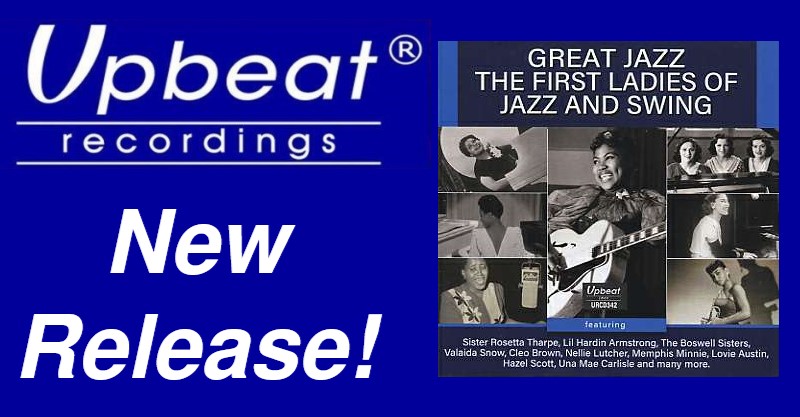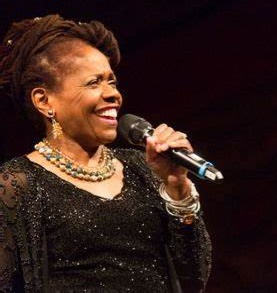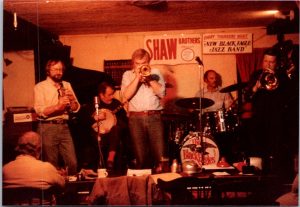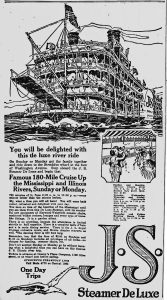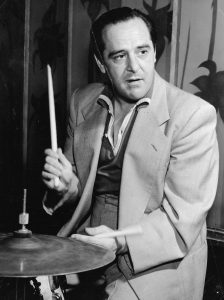 Set forth below is the fourteenth “Texas Shout” column. It first appeared in the February 1991 issue of the West Coast Rag, (Now Syncopated Times.)
Set forth below is the fourteenth “Texas Shout” column. It first appeared in the February 1991 issue of the West Coast Rag, (Now Syncopated Times.)
There are piles and piles of books about jazz. A few are brilliant, many are execrable, but about 99.9% of all jazz tomes have one thing in common. They are popular histories of the music.
A popular history of music concentrates primarily on background. That is, we can find many books that will tell us such things as when King Oliver came to Chicago, how Fats Waller died, Louis Armstrong’s favorite dish and the sad circumstances of Billie Holiday’s girlhood.
Few of these volumes, even ones solely devoted to a specific artist, spend very much time trying to tell us exactly what musical things the great musicians did that distinguished them from ordinary mortals. You will come away from popular histories knowing which players are the ones you should follow up, but too often you’ll have only a vague idea of why you should do so or of what you should listen for once you’ve located their recordings.
I have not reread any of the books I’m going to discuss today for purposes of this article, but I don’t think I need to do so. Over the four decades that I’ve been immersed in older-style jazz, ragtime and blues, I’ve only read a small handful of volumes that concentrated on the music. They made such an impression on me that I’d like to say a few things about them here for the benefit of those readers who are interested in delving into this part of the literature.
Some years back, Mike Mills, the trombonist in my Red Lion Jazz Band, brought a volume to a rehearsal that he’d received from a former colleague. It was about jazz, and Mike wanted my opinion of it. Not having heard of the book or its author, and having wasted many hours reading jazz books that are worse than useless, I had some misgivings, but I kept them to myself. After all, bandleaders do have some responsibilities toward keeping sidemen well fed and content.
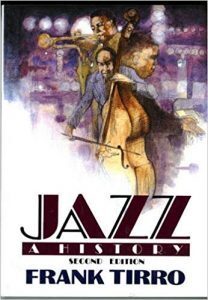 Thus it was that I became acquainted with Jazz: A History, by Frank Tirro. Not to put too fine a point on it, this is far and away the best book I have ever read from the viewpoint of explaining how the music should be approached by a critical listener.
Thus it was that I became acquainted with Jazz: A History, by Frank Tirro. Not to put too fine a point on it, this is far and away the best book I have ever read from the viewpoint of explaining how the music should be approached by a critical listener.
Tirro, an educator, designed his volume to be used in connection with a course in jazz appreciation. He recognized that, in order to understand comments about jazz performance, one must be able to hear the performance being discussed. His problem was that jazz recordings go in and out of print with frustrating frequency.
In a stroke of inspiration, Tirro decided to key his book to a several-LP set of widely-recognized classic jazz performances produced by The Smithsonian Institution. He reasoned, and he’s been right to date, that the Smithsonian, not being a record producer per se but a museum primarily focused on American culture, would keep the set available longer than the typical private record firm would maintain any group of jazz records on the market.
His book starts with ragtime and early Dixieland and progresses through the most advanced types of jazz. Tirro goes from performance to performance, telling you what parts of the rides are crucial, often setting forth the musical notation thereof.
I already owned, of course, all of the cited recordings in the styles that interested me, knowing them well enough that I could follow Tirro’s text without specific need to refer to the records. I found his analysis so insightful, and so well written, that I couldn’t put the book down, even when the chapters moved into forms of jazz that I don’t care for at all. In fact, as Tirro discussed some of the most modern recordings, I found myself wishing that I could hear the passages, even while recognizing that I would probably hate them if I did hear them!
Despite the numerous musical notations, I think that Tirro’s masterpiece could be grasped by someone who can’t read music, provided he has access to the records. However, some of you may not wish to peruse a volume that spends over half its space on music that is well beyond the scope of West Coast Rag. In that case, you might look for what I believe is the only other volume that can rank with Tirro’s, Early Jazz, by Gunther Schuller.
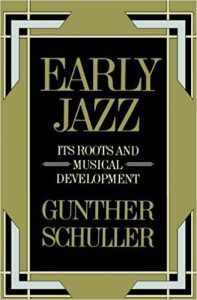 Schuller, also a music educator, focuses only on jazz prior to swing. His opening portion, covering pre-jazz musics and their contribution to jazz, is quite academic and very rough going even for a musician, but plow through it, skim it, or maybe skip it if you have no other alternative. The bulk of the volume discusses the kind of music covered every month in West Coast Rag, leading you through its development as found on records waxed during the pre-swing period.
Schuller, also a music educator, focuses only on jazz prior to swing. His opening portion, covering pre-jazz musics and their contribution to jazz, is quite academic and very rough going even for a musician, but plow through it, skim it, or maybe skip it if you have no other alternative. The bulk of the volume discusses the kind of music covered every month in West Coast Rag, leading you through its development as found on records waxed during the pre-swing period.
As might be expected, Schuller (as does Tirro) sees our music evolving via the efforts of certain great innovators. He organizes most of his chapters to center on those great names — Original Dixieland Jazz Band, Louis Armstrong, Bessie Smith, Duke Ellington, etc. — discussing, frequently with musical notation, the specific innovations that these figures brought to jazz. Because Schuller underwent the daunting task of hearing every pre-swing recording, he is well positioned to, and does, make sure you understand the musical context in which those innovations occurred.
As far as I know, these two volumes make up the top rank of books that cover our music other than as popular histories. However, if you want a few other suggestions of similar books in related areas, I’ll mention three.
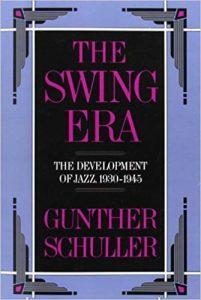 The Swing Era, by Gunther Schuller, does for jazz during the thirties and early forties what Early Jazz does for the preceding period. Because Schuller again tried to hear every recording, he had an almost impossible task. The Swing Era is rather lengthy, took him much longer to write than he expected, and probably because of the size of the undertaking and the text, is not quite as well-written or thought out as Early Jazz.
The Swing Era, by Gunther Schuller, does for jazz during the thirties and early forties what Early Jazz does for the preceding period. Because Schuller again tried to hear every recording, he had an almost impossible task. The Swing Era is rather lengthy, took him much longer to write than he expected, and probably because of the size of the undertaking and the text, is not quite as well-written or thought out as Early Jazz.
However, if Early Jazz rates an A-plus, The Swing Era rates no worse than an A. I hadn’t planned to read it, both because it was so thick and because swing is not my primary area of jazz interest. However, once the rave reviews began to pile up, I capitulated and found, once again, that I was reading it compulsively.
Schuller’s judgements are sound, informed and penetrating, usually in accordance with conventional wisdom but sometimes surprising (e.g., his well- supported conclusion that Cab Calloway was the most broadly gifted male vocalist of his day). There is a great deal in The Swing Era of direct relevance to fans of the music covered in West Coast Rag, such as the chapters on Louis Armstrong, Earl Hines, and Red Nichols.
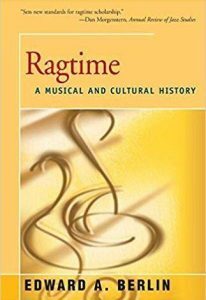 For those interested in ragtime, Ragtime: A Musical And Cultural History, by Edward A. Berlin, stands astride the limited shelf in this field as the best non-popular history you’ll find on the subject. With indefatigable thoroughness and keen musical understanding, Berlin has researched ragtime and the literature of the ragtime years. His slim but fact-filled volume describes how the music was perceived by the public and how it developed musical sophistication (his observations on mid-bar and cross-bar syncopations are a revelation).
For those interested in ragtime, Ragtime: A Musical And Cultural History, by Edward A. Berlin, stands astride the limited shelf in this field as the best non-popular history you’ll find on the subject. With indefatigable thoroughness and keen musical understanding, Berlin has researched ragtime and the literature of the ragtime years. His slim but fact-filled volume describes how the music was perceived by the public and how it developed musical sophistication (his observations on mid-bar and cross-bar syncopations are a revelation).
The best book ever written on ragtime, however, and one of the best books ever written about any kind of music, is still the pioneering They All Played Ragtime, by Rudi Blesh and Harriet Janis.
However, it is a popular history — a wonderful, romantic, accurate, exceptionally readable popular history — and so beyond the scope of today’s column.
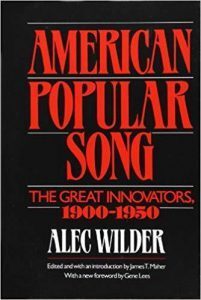 Finally, American Popular Song, by Alec Wilder, explains in musical terms what happened to take America’s popular songs out of the European parlor ballad stage and make them uniquely American. Wilder, himself a composer of quality pops, exhaustively researched the song libraries of top Tin Pan Alley publishing houses and discovered that, in general, American popular song developed through the efforts of a limited number of inspired composers who appeared on the scene after the initial rhythmic breakthroughs inaugurated by ragtime.
Finally, American Popular Song, by Alec Wilder, explains in musical terms what happened to take America’s popular songs out of the European parlor ballad stage and make them uniquely American. Wilder, himself a composer of quality pops, exhaustively researched the song libraries of top Tin Pan Alley publishing houses and discovered that, in general, American popular song developed through the efforts of a limited number of inspired composers who appeared on the scene after the initial rhythmic breakthroughs inaugurated by ragtime.
Wilder’s book is organized by chapters dealing with these composers, illustrating their innovations with portions of the music from the songs discussed. (An exception is Irving Berlin’s chapter — Berlin would not permit short quotes from his works without payment of full royalties.)
American Popular Song kept me mesmerized throughout. I gained new perspectives on tunes I’d played for years, and also some leads to others I hadn’t previously considered. I know of no other volume comparable to it. If you read it, you won’t learn what George Gershwin had for breakfast, but you will learn exactly why, for example, “Some Of These Days” was years ahead of its time and paved the way for similarly propulsive numbers that characterized the jazz age.
I have not listed publishers above because books, like records, go in and out of print in various formats from various publishing houses. However, I believe that all of the books mentioned in this column are available, some of them in relatively inexpensive trade paperback editions.
Why do you need a book to learn about such matters? Since jazz is a matter of listening, why can’t you find these subjects discussed on record or hear them at a concert?
Partly it’s because so many of the historically-oriented musical shows you’ll see are themselves popular histories. The band will tell you who the ODJB was, and when it recorded, and then play an ODJB tune — in the style of the band putting on the show. Then it will tell you something about King Oliver, or Jelly, or Satchmo, and punctuate that discussion by playing tunes associated with those names, again in its own style.
Thus, you’ll certainly learn what the group you’re listening to sounds like, but you’re unlikely to learn much about the musical differences among the artists being discussed. Even when the band is playing transcriptions of the old recordings, which will give you a leg up on hearing the differences between the renditions, its spoken introductions too often concentrate on personalities rather than music.
I want to emphasize that today’s column is not designed as a thinly- disguised elaborate lead-in to a plug for my own recordings. Nevertheless, to my knowledge, the only available records that attempt to teach the audience, via both spoken commentary and side-by-side musical demonstrations, how to listen to Dixieland jazz are the two jazz appreciation cassettes by The Rent Party Revellers produced by Dan Polin. I’d like to see more of that type of recording on the market, but I’m not aware of anything else that’s around.
[Ed. Note: These instructional tapes are now available as a 3-CD set, click here for our review.]
The books I’ve mentioned, though, should be easy to locate through any sizeable bookstore in your area, or maybe even your local public library. By taking them one at a time, reading them at your own pace, and digesting and thinking about what they have to say, I believe you will get even more enjoyment out of your recordings and out of the live concerts you attend. You might even find yourself liking a broader range of our music too. Why not give it a try?
Tex provides a reading list at his educational retreats including the above-mentioned books and many that he would consider popular histories. You can read his discussion of those popular histories in Texas Shout #25. The one additional book from that list that falls in the camp of being about the music rather than the personalities is:
Lost Chords: White Musicians And Their Contribution To Jazz, 1915-1945, by Richard M. Sudhalter
The complete list is here: Tex Wyndham’s Reading List
Back to the Texas Shout Index.

The full run of “Texas Shout” has been collected into a lavishly illustrated trade paperback entitled Texas Shout: How Dixieland Jazz Works. This book is available @ $20.00 plus $2.95 shipping from Tex Wyndham, On request, Tex will autograph the book and add a personalized note (be sure to tell him to whom the note should be addressed).
Tex Wyndham’s 3 CD Guide to Dixieland with music and commentary is available for $20 plus $2.95 shipping. The separate CD, A History of Ragtime: Tex Wyndham Live At Santa Rosa, is available for $13.00 plus $2.00 shipping. On request, Tex will autograph the inner sleeve and add a personalized note (be sure to tell him to whom the note should be addressed).
Send payment to Tex Wyndham, P.O. Box 831, Mendenhall, PA 19357, Phone (610) 388-6330.
Note: All links, pictures, videos or graphics accompanying the Shouts were added at the discretion of the Syncopated Times editorial staff. They did not accompany the original columns and do not necessarily reflect the opinion of Tex Wyndham.
From roughly 1970-2010, Tex Wyndham was: (1) one of the best-known revivalist Dixieland jazz musicians in the US, as cornetist, pianist and bandleader, (2) one of the best-known ragtime pianists in the US, and (3) one of the most respected critics in the US of Dixieland jazz, ragtime, and related music. He is the only person about whom all three of those statements can be made.


